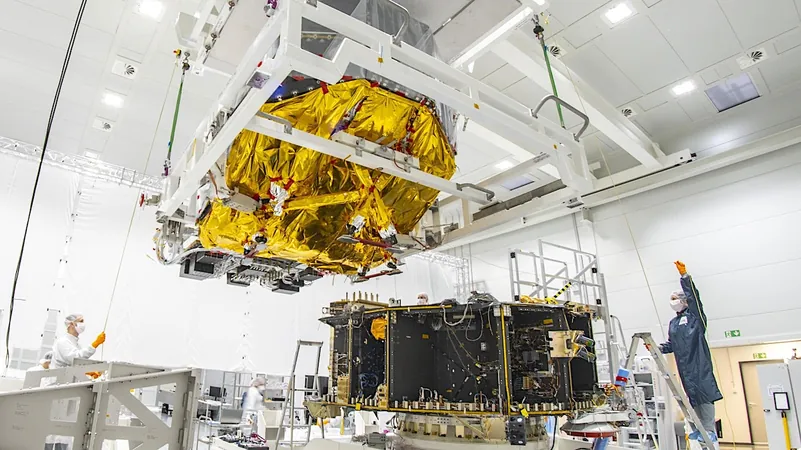
The PLATO Space Telescope: A Leap Towards Discovering Earth-like Planets
2025-07-02
Author: Arjun
Unlocking the Secrets of the Universe
Are there planets akin to Earth, spinning around stars like our Sun? The European Space Agency (ESA) aims to answer these profound questions with its groundbreaking PLATO (PLAnetary Transits and Oscillations of stars) mission, set to launch at the end of 2026. From 2027 onward, this revolutionary space telescope will embark on a quest to find Earth-sized planets in distant solar systems.
A Historic Milestone Achieved
In a significant leap forward for the project, the integration of PLATO’s two main components was successfully completed from June 10 to 13, 2025, at aerospace technology firm OHB in Germany. This logistical triumph not only showcases Germany's pivotal role in the construction and operation of PLATO but also underscores the collaborative strength of an international scientific team led by the German Aerospace Center (DLR).
"Almost eight years to the day since the mission was greenlit, both the satellite and its remarkable telescope, equipped with 26 'eyes,' have reached completion ahead of schedule," remarked Heike Rauer, the mission’s scientific lead. Her enthusiasm reflects the monumental effort behind this achievement.
A Telescope Like No Other
What sets PLATO apart from other space telescopes is its unique approach—utilizing 26 cameras instead of a single complicated one. This innovative setup allows for the monitoring of an astounding 250,000 stars for potential planetary discoveries. Built and tested across various nations, these cameras are expected to meet high standards of measurement accuracy.
Preparing for Space: Millimeter-Level Precision
The intricate assembly of the 26 cameras occurred within the sterile confines of OHB's cleanroom. The optical bench that supports these cameras was aligned with remarkable precision above the spacecraft’s service module, which houses vital systems for flight control and scientific data transmission. Following a volley of electrical testing, the components were seamlessly integrated.
Next Steps on the Journey to Discovery
With the integration completed, PLATO is poised for its next stage—a transport to ESA's Space Research and Technology Centre in the Netherlands for solar panel and sunshield installation. Following rigorous testing in a space simulation chamber, the spacecraft will travel to the Kourou launch site in French Guiana, gearing up for a December 2026 launch aboard an Ariane 6 rocket.
Scouting the Stars: 26 Cameras on a Mission
PLATO's revolutionary design, featuring 26 cameras on a shared platform, will scrutinize an estimated 250,000 stars, looking for orbiting planets. Positioned at the second Lagrange point (L2)—1.5 million kilometers from Earth, where the James Webb Space Telescope also resides—scientists anticipate the mission could uncover thousands of rocky, icy, and gaseous planets across different star types.
How PLATO Detects Exoplanets
Employing the transit method, the same technique utilized by previous missions like CoRoT and Kepler, PLATO will identify planets by observing slight reductions in starlight caused by a transit event. These observations will then be examined in greater detail from ground-based telescopes.
Precision in Data Collection
While all cameras share a common optical design, they vary in data processing speeds—two "fast" cameras refresh every 2.5 seconds, while 24 "normal" cameras refresh every 25 seconds. This dual system positions the fast cameras as navigational aid while the normal cameras document the light curves critical for identifying exoplanetary signatures.
A Collaborative Endeavor
Led by DLR, an international consortium is developing PLATO’s scientific payload, while ESA oversees the mission’s broader structure, including launch and operations. The Max Planck Institute for Solar System Research coordinates the PLATO data center, with German institutions extensively involved in the project’s progress and data analysis.
Funding for A New Era in Astronomy
The German Space Agency is heavily investing in the payload development and operational logistics with support from the Federal Government, ensuring that PLATO will not only scientifically enrich our understanding of the universe but also serve as a beacon for future explorations.
As PLATO prepares to unveil the mysteries of the cosmos, excitement builds over the potential discoveries that could alter our understanding of Earth's place in the universe.

 Brasil (PT)
Brasil (PT)
 Canada (EN)
Canada (EN)
 Chile (ES)
Chile (ES)
 Česko (CS)
Česko (CS)
 대한민국 (KO)
대한민국 (KO)
 España (ES)
España (ES)
 France (FR)
France (FR)
 Hong Kong (EN)
Hong Kong (EN)
 Italia (IT)
Italia (IT)
 日本 (JA)
日本 (JA)
 Magyarország (HU)
Magyarország (HU)
 Norge (NO)
Norge (NO)
 Polska (PL)
Polska (PL)
 Schweiz (DE)
Schweiz (DE)
 Singapore (EN)
Singapore (EN)
 Sverige (SV)
Sverige (SV)
 Suomi (FI)
Suomi (FI)
 Türkiye (TR)
Türkiye (TR)
 الإمارات العربية المتحدة (AR)
الإمارات العربية المتحدة (AR)